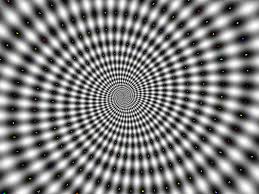|
The illusion of movement is achieved by creating instability in the image, for instance, adding a blurred background to the image. Movement can be achieved by using graphic elements that direct the eye in a certain direction, such as arrows that point the way, or a series of lines or dots that get progressively larger or smaller, creating a more subtle sense of movement. Movement can be accomplished simply by using a photograph or clip art of something moving - like a runner - as opposed to something stationary - like a person standing.
Anticipated & Blurry Movement
Live figures portrayed in unstable body positions cause us to feel that motion is imminent. We know from past experience with these positions that some kind of movement will occur soon. This heightens the feeling of motion.
 
When figures move past us at very high speeds, we perceive that figure as somewhat blurry. This can be achieved while capturing an image with a camera or digitally using an image editing program like Adobe Photoshop. This experience leads us to interpret blurry or indistinct outlines as conveying motion. Automobile manufacturers use movement in still photos to imply the speed of their car.
Multiple Image

Similarly, showing multiple overlapping images gives us the impression of motion. We can see that the person or figure has moved through a series of poses.
Optical Movement

In optical movement, the eye is forced to move around the picture in order to see all the different elements. Optical movement can be enhanced by curved forms that keep your eyes moving in a circular pattern throughout the picture, like in the circular flow chart above on the left. The example above on the right uses the progression of colour (rainbow) to create optical movement from yellow to green, as well as counting from one to nine. The Audi website below uses arrows to move the viewers attention from left to right.

Optical Illusions
Certain optical illusions based on the repetition of geometric forms will cause your eye to produce motion where none is present. This picture really seems to move, doesn't it? For some fun optical illusions and the explanation for why you interpret them the way you do visit LottoLab.

Rhythm and Movement
Rhythm refers to the way your eye moves throughout a picture. Some pictures move you throughout in a connected, flowing way, much like a slow, stately rhythm in music. Other pictures move you from one place to another in an abrupt, dynamic way, much like a fast, staccato rhythm in music. This is intended to give you the impression of movement. Rhythm in art is created by the repetition of elements. Similarity of elements, or flowing, circular elements will give a more connected flowing rhythm to a picture. Jagged or unrelated elements will create a more unsettling, dynamic picture.
|



 Try This:
Try This: